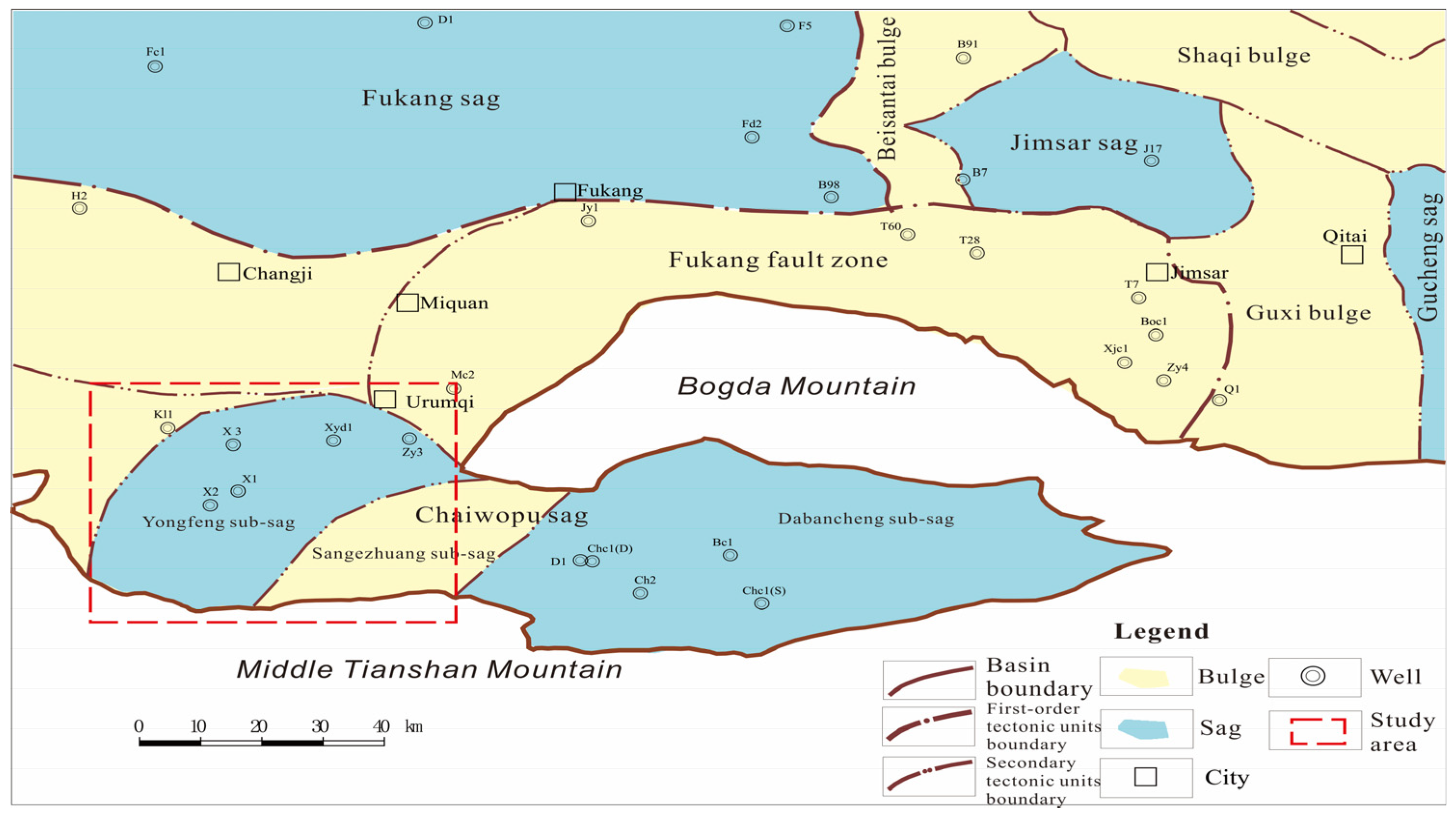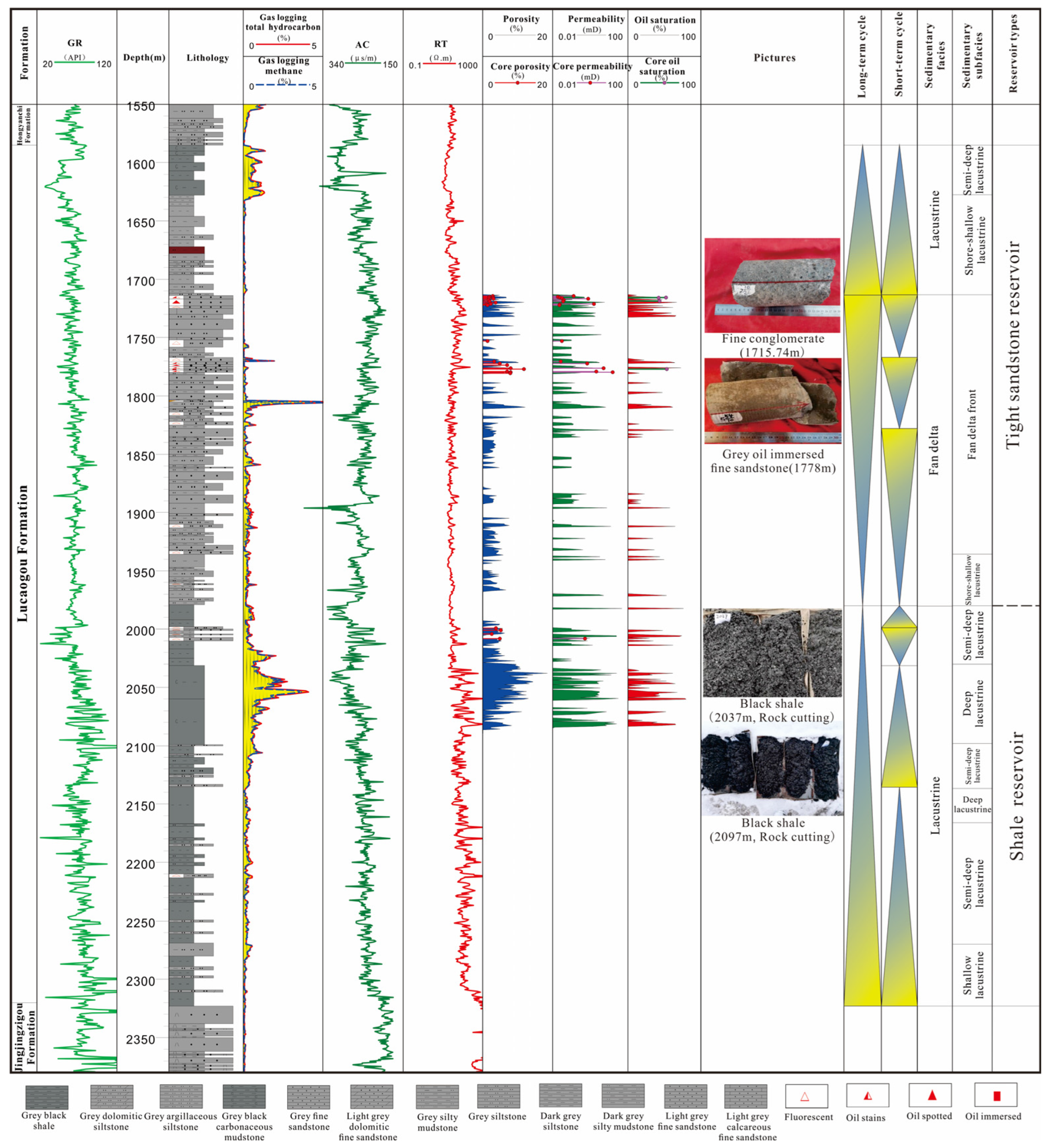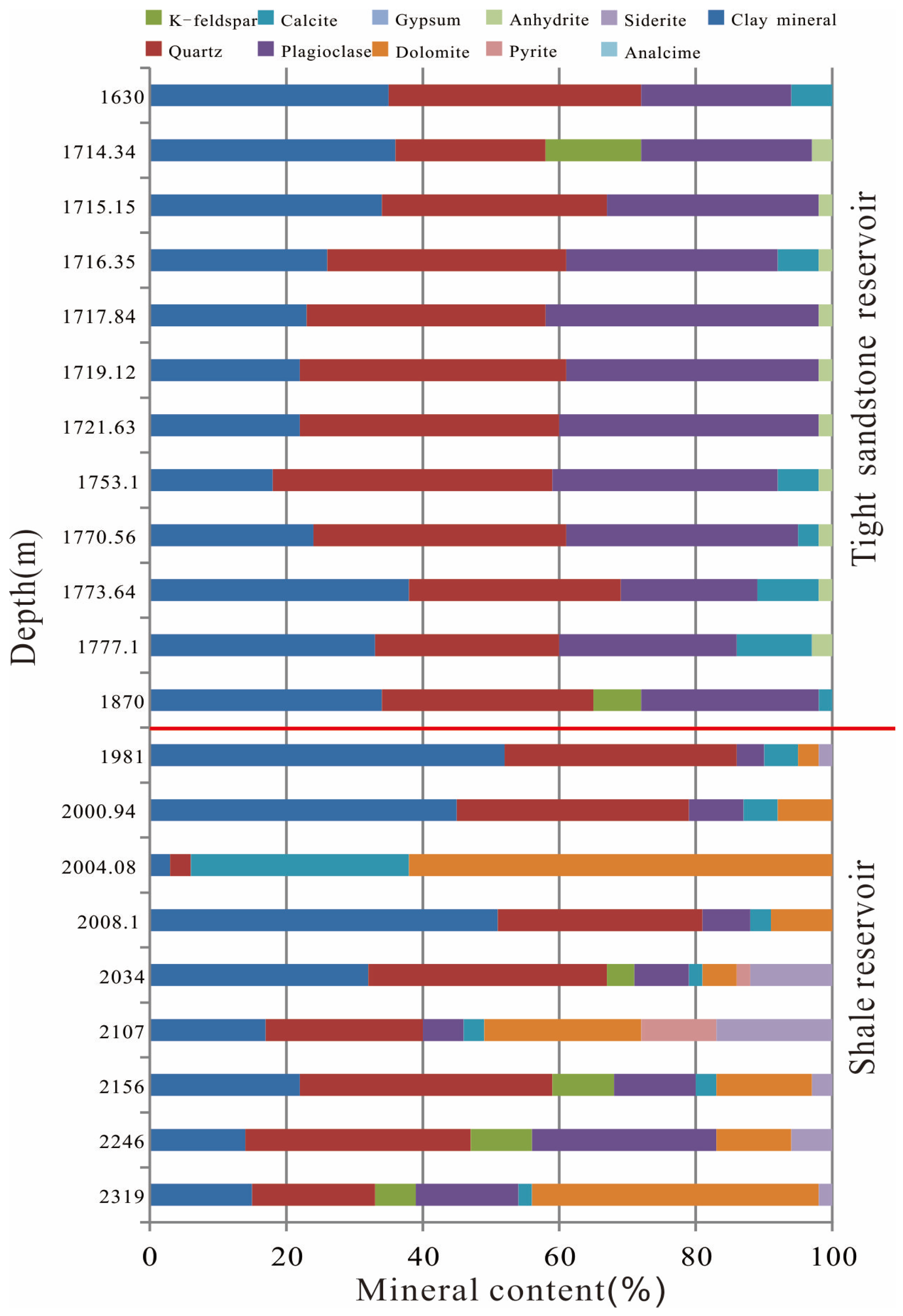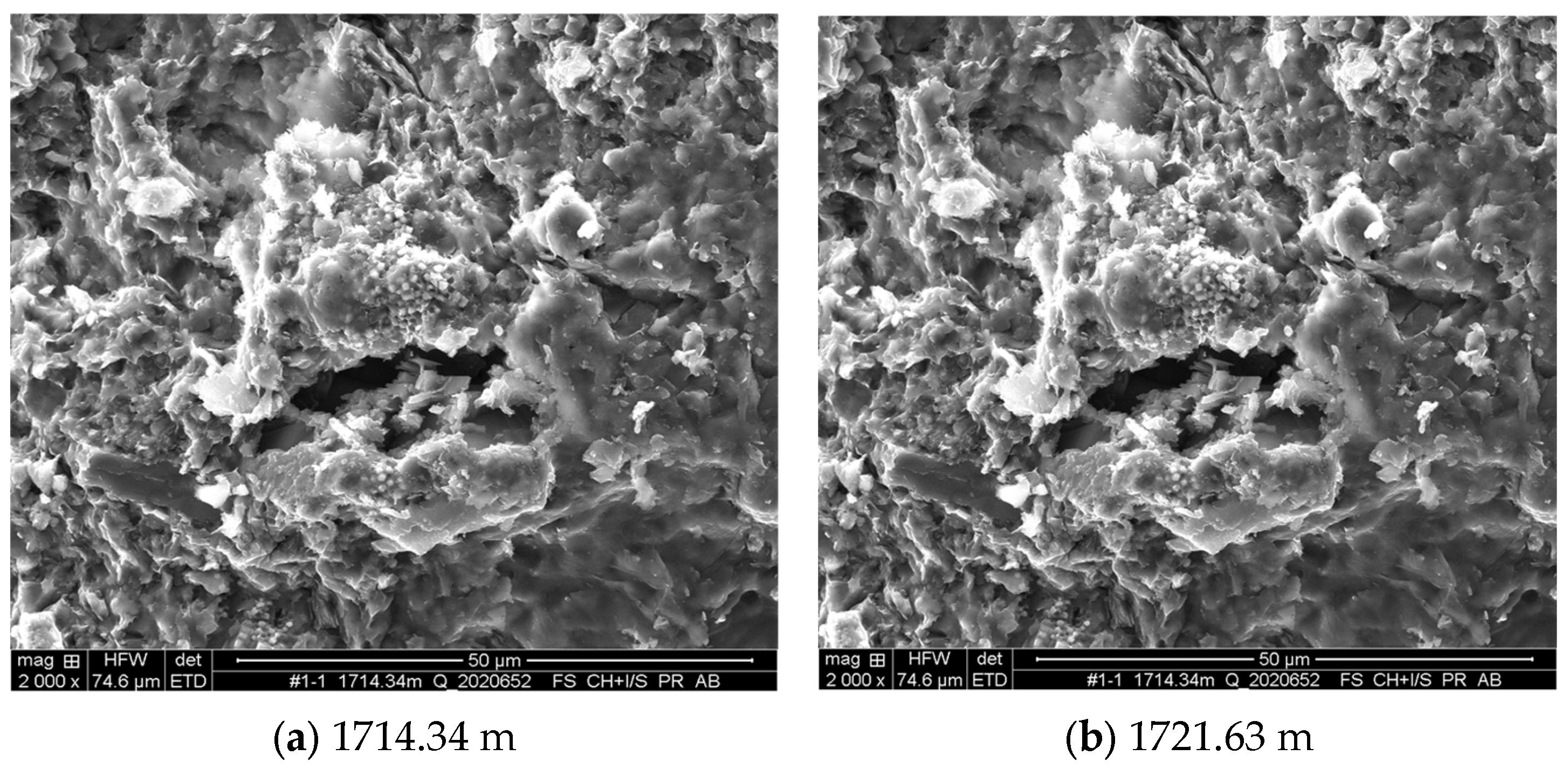Tight Reservoir Characteristics and Controlling Factors of Permian Lucaogou Formation in Yongfeng Sub-Sag, Chaiwopu Sag
Abstract
:1. Introduction
2. Regional Geological Condition
3. Lithology of the Tight Reservoir
3.1. Sample Collection and Analysis
3.2. Petrological Characteristics
3.3. Characteristics of Mineral Composition
3.4. Physical Properties of Reservoir
3.5. Types and Characteristics of Reservoir Space
3.5.1. Primary Pores
3.5.2. Secondary Dissolution Pores
3.5.3. Fractures
3.6. Reservoir Brittleness and Water Sensitivity
4. Controlling Factors of Reservoir
4.1. Impact of Sedimentary Facies on Reservoirs
4.2. Impact of Lithology on Reservoir
4.3. Impact of Diagenesis on Reservoir
4.4. Impact of Tectonic Movements and Fractures on Reservoir
5. Conclusions
- The Permian Lucaogou Formation in the study area can be divided into upper and lower lithological sections. The upper section develops a set of fan delta front facies siltstone deposits, mainly composed of lithic sandstone with low compositional maturity and poor reservoir physical properties. It is a tight sandstone reservoir with low porosity and low permeability. The reservoir space is mainly secondary pores, including intergranular dissolved pores, intragranular dissolved pores and fractures. The primary pores are severely damaged, and only residual intergranular pores are developed.
- The tight sandstone reservoir in the upper part of the Lucaogou Formation in the study area has high brittleness and low water sensitivity, which is very conducive to large-scale hydraulic fracturing to transform the reservoir and improve oil and gas production capacity.
- The development of tight reservoirs in the Lucaogou Formation in the study area is mainly controlled by sedimentary facies, lithology, diagenesis and later tectonic movement. These factors are interrelated in controlling reservoirs, but their magnitude of action varies. Sedimentary facies is the core controlling factor. Diagenesis has a decisive impact on the physical properties of the reservoir. Later tectonic movements and fractures have a significant impact on improving reservoir physical properties and seepage capacity.
Author Contributions
Funding
Data Availability Statement
Conflicts of Interest
References
- Klemme, H.D.; Ulmishek, G.F. Effective petroleum source rocks of the world; stratigraphic distribution and controlling depositional factors. AAPG Bull. 1991, 75, 1809–1851. [Google Scholar]
- Wilson, R.D.; Chitale, J.; Huffman, K.; Montgomery, P.; Prochnow, S.J. Evaluating the depositional environment, lithofacies variation, and diagenetic processes of the wolfcamp b and lower spraberry intervals in the midland basin: Implications for reservoir quality and distribution. AAPG Bull. 2020, 104, 1287–1321. [Google Scholar] [CrossRef]
- Zhang, T.; Fu, Q.; Sun, X.; Hackley, P.C.; Ko, L.T.; Shao, D. Meter-scale lithofacies cycle and controls on variations in oil saturation, Wolfcamp A, Delaware and Midland Basins. AAPG Bull. 2021, 105, 1821–1846. [Google Scholar] [CrossRef]
- Zhi, D.; Tang, Y.; He, W.; Guo, X.; Zheng, M.; Huang, L. Orderly coexistence and accumulation models of conventional and unconventional hydrocarbons in Lower Permian Fengcheng Formation, Mahu Sag, Junggar Basin. Pet. Explor. Dev. 2021, 48, 38–51. [Google Scholar] [CrossRef]
- Hu, S.; Wang, X.; Cao, Z.; Li, J.; Gong, D.; Xu, Y. Formation conditions and exploration direction of large and medium gas reservoirs in the Junggar Basin, NW China. Pet. Explor. Dev. 2020, 47, 247–259. [Google Scholar] [CrossRef]
- Nazari, M.H.; Tavakoli, V.; Rahimpour-Bonab, H.; Sharifi-Yazdi, M. Investigation of factors influencing geological heterogeneity in tight gas carbonates, Permian reservoir of the Persian Gulf. J. Pet. Sci. Eng. 2019, 183, 106341. [Google Scholar] [CrossRef]
- Zou, C.; Yang, Z.; Zhang, G.; Zhu, R.; Tao, S.; Yuan, X.; Hou, L.; Dong, D.; Guo, Q.; Song, Y.; et al. Theory, technology and practice of unconventional petroleum geology. Earth Sci. 2023, 48, 2376–2397. [Google Scholar] [CrossRef]
- Yang, Z.; Zou, C. “Exploring petroleum inside source kitchen”: Connotation and prospects of source rock oil and gas. Pet. Explor. Dev. 2019, 46, 173–184. [Google Scholar] [CrossRef]
- Yang, Z.; Zou, C.; Chen, J.; Wu, S.; Pan, S.; Ma, F.; Li, J.; Jiang, W.; Wang, X. “Exploring Petroleum inside or near the Source Kitchen”: Innovations in Petroleum Geology Theory and Reflections on Hydrocarbon Exploration in Key Fields. Acta Pet. Sin. 2021, 42, 1310–1324. [Google Scholar]
- Zou, C.; Yang, Z.; Dong, D.; Zhao, Q.; Chen, Z.; Feng, Y.; Li, J.; Wang, X. Formation, distribution and prospect of unconventional hydrocarbons in source rock strata in China. Earth Sci. 2022, 47, 1517–1533. [Google Scholar]
- Jiang, F.; Hu, M.; Hu, T.; Lyu, J.; Huang, L.; Liu, C.; Jiang, Z.; Huang, R.; Zhang, C.; Wu, G.; et al. Controlling factors and models of shale oil enrichment in Lower Permian Fengcheng Formation, Mahu Sag, Junggar Basin, NW China. Pet. Explor. Dev. 2023, 50, 706–718. [Google Scholar] [CrossRef]
- Tang, Y.; Lyu, Z.; He, W.; Ji, Y.; Li, X.; Song, X.; Yang, S.; Cao, Q.; Qian, Y.; Zhao, X. Origin of dolomites in the Permian dolomitic reservoirs of Fengcheng Formation in Mahu Sag, Junggar Basin, NW China. Pet. Explor. Dev. 2023, 50, 38–50. [Google Scholar] [CrossRef]
- Kuang, L.; Tang, Y.; Lei, D.; Chang, Q.; Ou, Y.; Hou, L.; Liu, D. Formation conditions and exploration potential of tight oil in the Permian saline lacustrine dolomitic rock, Junggar basin, NW China. Pet. Explor. Dev. 2012, 39, 657–667. [Google Scholar] [CrossRef]
- Zhang, C.; Cao, J.; Wang, Y.; Zhi, D.; Xiang, B.; Li, E. Enrichment law of shale oil of Lucaogou Formation in Jimusar sag, Junggar Basin. Acta Pet. Sin. 2022, 43, 1253–1268. [Google Scholar]
- Shao, Y.; Yang, Y.; Wan, M.; Qiu, L.; Cao, Y.; Yang, S. Sedimentary characteristic and facies evolution of Permian Lucaogou formation in Jimsar sag, Junggar basin. Xinjiang Pet. Geol. 2015, 36, 635–641. [Google Scholar]
- Kuang, L.; Hu, W.; Wang, X.; Wu, H.; Wang, X. Research of the tight oil reservoir in the Lucaogou formation in Jimusar sag: Analysis of lithology and porosity characteristics. Geol. J. China Univ. 2013, 19, 529–535. [Google Scholar]
- Cao, Y.; Zhu, N.; Zhang, S.; Xi, K.; Xue, X. Diagenesis and reserving space characteristics of tight oil reservoirs of Permian Lucaogou formation in Jimusar sag of Junggar basin. J. Earth Sci. Environ. 2019, 41, 253–266. [Google Scholar]
- Song, Y.; Zhou, L.; Guo, X.; Chang, Q.; Wang, X. Characteristics and occurrence of lacustrine dolomitic tight oil reservoir in the Middle Permian Lucaogou formation, Jimusaer sag, southeastern Junggar basin. Acta Petrol. Sin. 2017, 33, 1159–1170. [Google Scholar]
- Xu, L.; Chang, Q.; Yang, C.; Tao, Q.; Wang, S.; Fei, L.; Xu, S. Characteristics and oil-bearing capability of shale oil reservoir in the Permian Lucaogou formation, Jimusaer sag. Oil Gas Geol. 2019, 40, 535–549. [Google Scholar]
- Zha, M.; Su, Y.; Gao, C.; Qu, J.; Wang, X.; Ding, X. Tight reservoir space characteristics and controlling factors: An example from Permian Lucaogou Formation in Jimsar sag, Junggar basin, northwest China. J. China Univ. Min. Technol. 2017, 46, 85–95. [Google Scholar]
- Zhi, D.; Tang, Y.; Yang, Z.; Guo, X.; Zheng, M.; Wan, M.; Huang, L. Geological characteristics and accumulation mechanism of continental shale oil in Jimusaer sag, Junggar basin. Oil Gas Geol. 2019, 40, 524–534. [Google Scholar]
- Qiu, Z.; Shi, Z.; Dong, D.; Lu, B.; Zhang, C.; Zhou, J.; Wang, H.; Xiong, B.; Pang, Z. Geological characteristics of source rock and reservoir of tight oil and its accumulation mechanism: A case study of Permian Lucaogou formation in Jimusar sag, Junggar basin. Pet. Explor. Dev. 2016, 43, 928–939. [Google Scholar] [CrossRef]
- Yang, Y.; Zhang, J.; Zhang, J.; Gao, Y.; Zhou, X.; Sun, X.; Wen, L.; Miao, M. Sedimentary characteristics and main controlling factors of the Middle-Upper Permian and Middle-Upper Triassic around Bogda Mountain of Xinjiang, NW China. Pet. Explor. Dev. 2022, 49, 670–682. [Google Scholar] [CrossRef]
- Wang, S. Reservoir Characteristics and Oil-Bearing Properties of Different Lithofacies of Lucaogou Formation in the Piedmont Belt of Bogda Mountain. Xinjiang Pet. Geol. 2020, 41, 402–413. [Google Scholar]
- Ma, K.; Hou, J.; Liu, Y.; Shi, Y.; Yan, L.; Chen, F. The sedimentary model of saline lacustrine mixed sedimentation in Permian Lucaogou formation, Jimsar sag. Acta Pet. Sin. 2017, 38, 636–648. [Google Scholar]
- Qu, C.; Qiu, L.; Yang, Y.; Chen, C.; Tang, L.; Yu, K.; Wan, M. Carbon and oxygen isotope compositions of carbonatic rock from Permian Lucaogou formation in the Jimsar sag, NW China and their paleolimnological significance. Acta Geol. Sin. 2017, 91, 605–616. [Google Scholar]
- Wang, Y.; Zhang, K.; Lin, H.; Chen, S.; Zhang, G.; Wang, Y. Controlling factors and model of mixed deposits of Lucaogou Formation on the periphery of Bogda Mountainp. Xinjiang Pet. Geol. 2017, 38, 686–692. [Google Scholar]







| Sample | Depth/m | Lithology | Porosity/% | Permeability/mD |
|---|---|---|---|---|
| 1-1 | 1714.34 | Gray Fluorescent Argillaceous Silt-stone | 2.9 | 0.13 |
| 1-2 | 1715.15 | Gray Oil Stained Fine Sandstone | 1.9 | 0.019 |
| 1-3 | 1715.74 | Gray Oil Stained Gritstone | 3 | 0.024 |
| 2-1 | 1715.8 | Gray Oil Stained Gritstone | 4.7 | 0.038 |
| 2-2 | 1715.89 | Gray Oil Stained Gritstone | 4.9 | 0.03 |
| 1-4 | 1716.35 | Gray Oil Stained Fine Sandstone | 1.8 | 0.032 |
| 1-5 | 1716.73 | Gray Fluorescent Siltstone | 3.1 | 0.775 |
| 1-6 | 1717.84 | Gray Oil Spotted Fine Sandstone | 1.7 | 0.039 |
| 2-3 | 1718.82 | Gray Oil Spotted Fine Sandstone | 5.4 | 0.028 |
| 1-7 | 1719.12 | Gray Oil Spotted Fine Sandstone | 2 | 0.036 |
| 1-8 | 1720.04 | Gray Fluorescent Fine Sandstone | 3.7 | — |
| 1-9 | 1721.37 | Gray Oil Stained Fine Sandstone | 2.3 | 1.57 |
| 1-10 | 1721.63 | Gray Oil Immersed Fine Sandstone | 1.1 | 0.024 |
| 1-11 | 1722.33 | Gray Fluorescent Fine Sandstone | 1.4 | 0.023 |
| 1-12 | 1753.1 | Gray Fluorescent Siltstone | 1.4 | 0.031 |
| 1-13 | 1770.56 | Gray Fluorescent Fine Sandstone | 3.3 | 0.027 |
| 1-14 | 1772.24 | Gray Oil Stained Fine Sandstone | 4.9 | 0.686 |
| 1-15 | 1773.64 | Gray Oil Spotted Medium Sandstone | 7 | — |
| 1-16 | 1776.29 | Gray Oil Stained Fine Sandstone | 8 | 5.1 |
| 1-17 | 1777.1 | Gray Oil Immersed Glutenite | 11.8 | — |
| 2-4 | 1777.16 | Gray Oil Immersed Glutenite | 10.1 | — |
| 1-18 | 1779.2 | Gray Oil Stained Fine Sandstone | 7 | 2.09 |
| 1-19 | 1779.79 | Gray Oil Spotted Fine Sandstone | 8 | 15.5 |
| 1-20 | 1780.64 | Gray Fluorescent Fine Sandstone | 7.9 | — |
| 1-21 | 1999.32 | Gray Fluorescent Siltstone | 3.8 | — |
| 1-22 | 2000.94 | Light Gray Fluorescent Dolomite Fine Sandstone | 5.2 | — |
| 1-23 | 2004.08 | Light Gray Fluorescent Dolomite Fine Sandstone | 2.6 | — |
| 1-24 | 2008.1 | Gray Fluorescent Fine Sandstone | 4.9 | 0.524 |
| Top Depth/m | Bottom Depth/m | Fracture Feature | Fracture Filling Degree | Oil and Gas Show of the Corresponding Core Section | ||
|---|---|---|---|---|---|---|
| Diagonal Fracture | Longitudinal Fracture | Cross Fracture | ||||
| 1714.34 | 1716.81 | 9 | 1 | 0 | Full Filled to Half-Filled | Fluorescence, Oil Stained |
| 1721.63 | 1725.08 | 14 | 1 | 0 | Full Filled to Half-Filled | Oil Immersion, Fluorescence |
| 1726.57 | 1729.59 | 12 | 0 | 0 | Full Filled | No Oil and Gas Show |
| 1730.52 | 1732.75 | 9 | 0 | 0 | Full Filled | No Oil and Gas Show |
| 1737.12 | 1743.26 | 0 | 2 | 0 | Half-Filled | Intermittent escape of pinpoint bubbles |
| 1744.62 | 1745.01 | 1 | 0 | 0 | Full Filled to Half-Filled | Intermittent escape of pinpoint bubbles |
| 1771.44 | 1777.51 | 17 | 5 | 1 | Full Filled to Half-Filled | Oil Stained, Oil Spotted, Oil Immersion |
| 1778.12 | 1780.76 | 3 | 0 | 0 | Full Filled to Half-Filled | Oil Stained, Oil Spotted, Fluorescence |
| Sample | Well Depth (m) | Lithology | Relative Content of Clay Minerals/% | ||||
|---|---|---|---|---|---|---|---|
| Mixed Layer Illite/Smectite | Illite | Kaolinite | Chlorite | Ratio of Mixed Layer Illite/Smectite | |||
| 1-1 | 1714.34 | Gray Fluorescent Argillaceous Siltstone | 38 | 40 | 6 | 16 | 20 |
| 1-2 | 1715.15 | Gray Oil Stained Fine Sandstone | 42 | 39 | 5 | 14 | 20 |
| 1-4 | 1716.35 | Gray Oil Stained Fine Sandstone | 38 | 37 | 19 | 6 | 20 |
| 1-6 | 1717.84 | Gray Oil Spotted Fine Sandstone | 25 | 35 | 15 | 25 | 20 |
| 1-7 | 1719.12 | Gray Oil Spotted Fine Sandstone | 41 | 21 | 4 | 34 | 20 |
| 1-10 | 1721.63 | Gray Oil Immersed Fine Sandstone | 16 | 23 | 24 | 37 | 20 |
| 1-12 | 1753.1 | Gray Fluorescent Siltstone | 57 | 18 | 8 | 17 | 20 |
| 1-13 | 1770.56 | Gray Fluorescent Fine Sandstone | 25 | 25 | 15 | 35 | 20 |
| 1-15 | 1773.64 | Gray Oil Spotted Medium Sandstone | 38 | 45 | 6 | 11 | 20 |
| 1-17 | 1777.1 | Gray Oil Immersed sand-conglomerate | 24 | 38 | 16 | 22 | 20 |
Disclaimer/Publisher’s Note: The statements, opinions and data contained in all publications are solely those of the individual author(s) and contributor(s) and not of MDPI and/or the editor(s). MDPI and/or the editor(s) disclaim responsibility for any injury to people or property resulting from any ideas, methods, instructions or products referred to in the content. |
© 2023 by the authors. Licensee MDPI, Basel, Switzerland. This article is an open access article distributed under the terms and conditions of the Creative Commons Attribution (CC BY) license (https://creativecommons.org/licenses/by/4.0/).
Share and Cite
Wu, P.; Zhao, P.; Chen, Y.; Yang, H.; Yang, Y.; Dong, Q.; Chang, Y.; Wen, L.; Yuan, K.; Du, Y.; et al. Tight Reservoir Characteristics and Controlling Factors of Permian Lucaogou Formation in Yongfeng Sub-Sag, Chaiwopu Sag. Processes 2023, 11, 3068. https://doi.org/10.3390/pr11113068
Wu P, Zhao P, Chen Y, Yang H, Yang Y, Dong Q, Chang Y, Wen L, Yuan K, Du Y, et al. Tight Reservoir Characteristics and Controlling Factors of Permian Lucaogou Formation in Yongfeng Sub-Sag, Chaiwopu Sag. Processes. 2023; 11(11):3068. https://doi.org/10.3390/pr11113068
Chicago/Turabian StyleWu, Peng, Peihua Zhao, Yi Chen, Haixing Yang, Yun Yang, Qiu Dong, Yihang Chang, Lei Wen, Kun Yuan, Yukun Du, and et al. 2023. "Tight Reservoir Characteristics and Controlling Factors of Permian Lucaogou Formation in Yongfeng Sub-Sag, Chaiwopu Sag" Processes 11, no. 11: 3068. https://doi.org/10.3390/pr11113068






